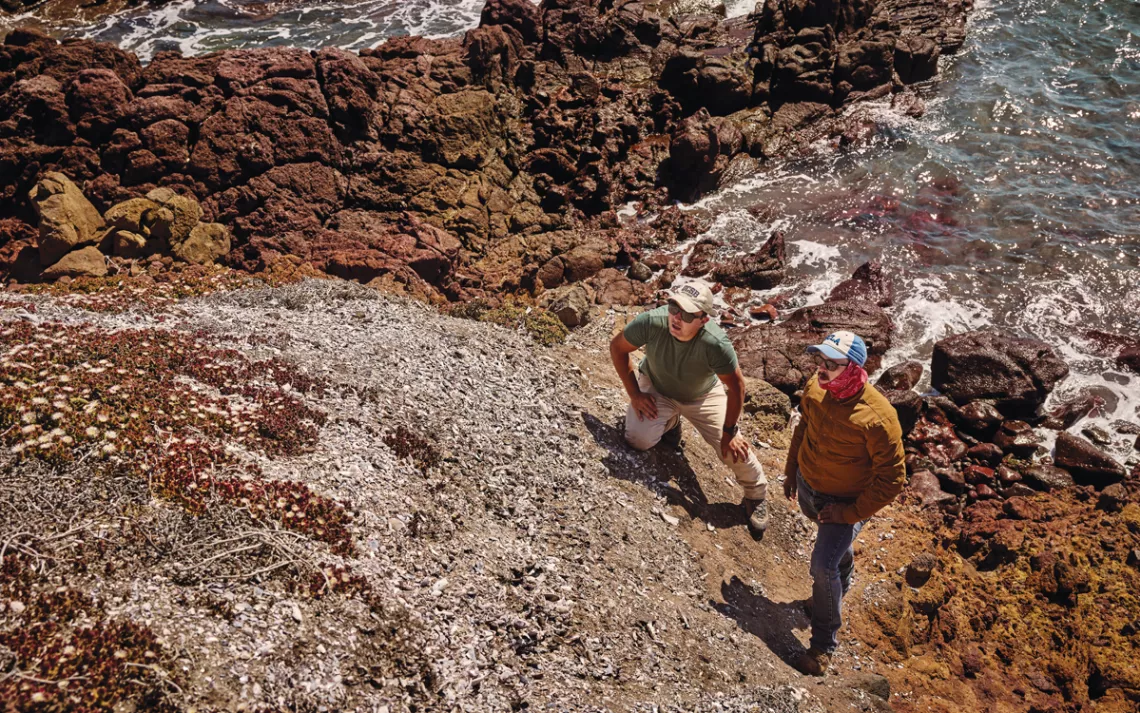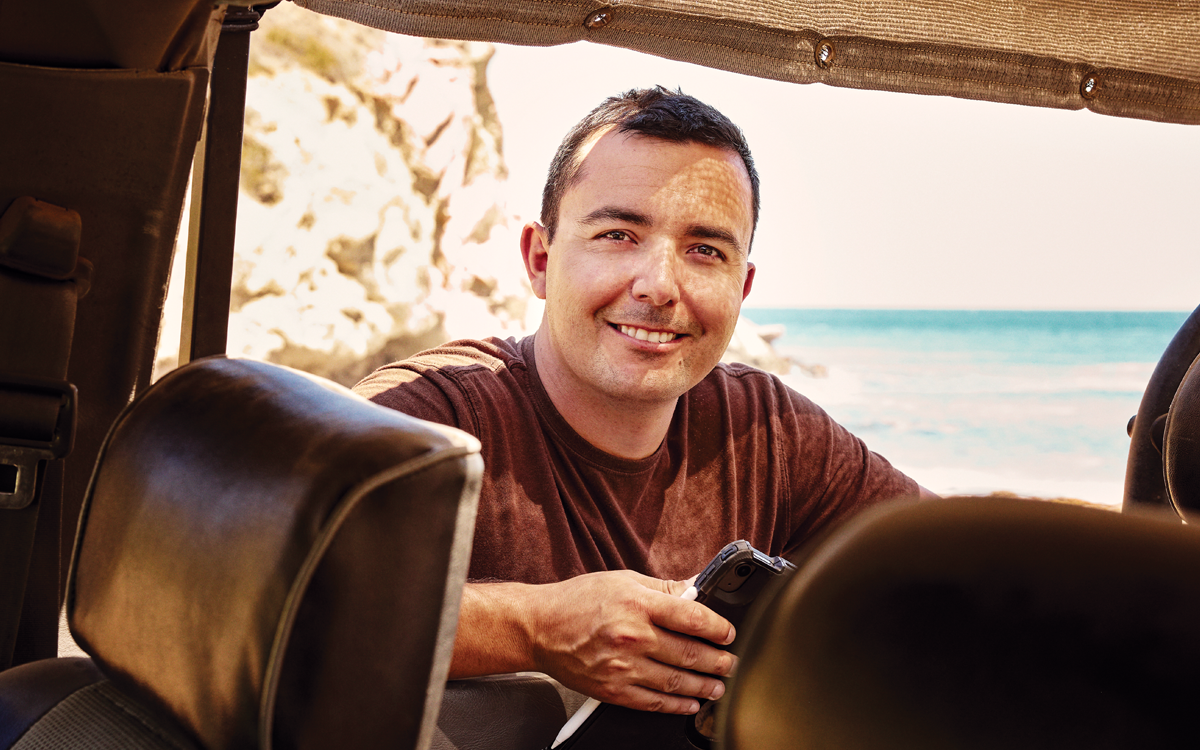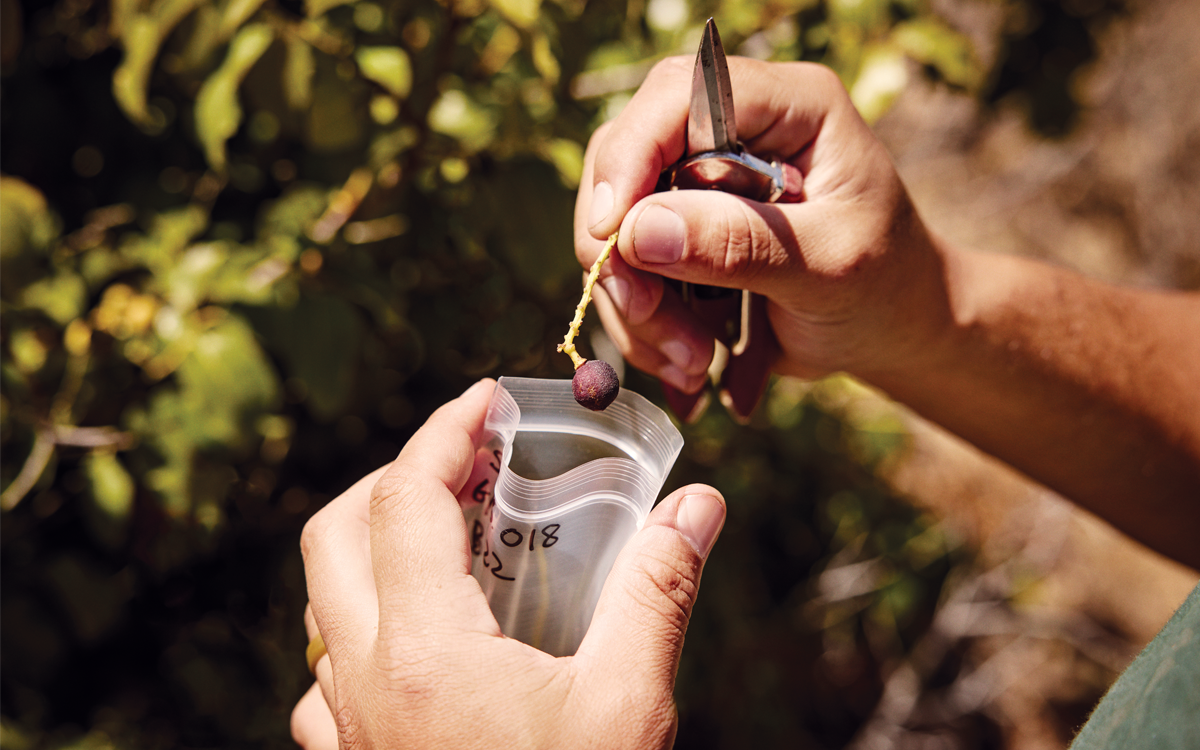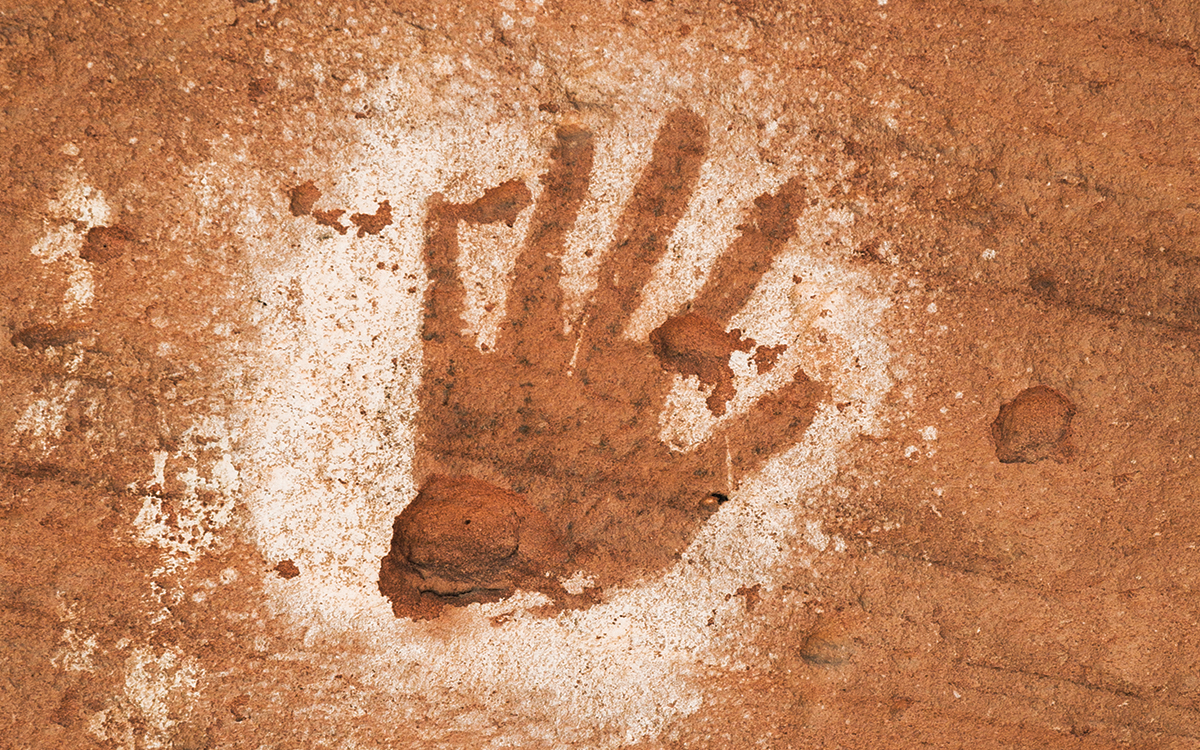Digging for Answers
In California, an Indigenous archaeologist uncovers his own culture

Archaeologists examine a 1,000-year-old shell midden in Channel Islands National Park, traditional lands of the Chumash. | Photos by Gabriel Nivera
Near Coches Prietos beach on California's Santa Cruz Island, archaeologist Brian Holguin points out a thin blue flower with a strawlike stem and a small bulb that looks like a baby onion. The Indigenous Chumash name for the plant is is'q'o, says Eleanor Fishburn, an anthropology student of Ventureño and Barbareño Chumash descent who has accompanied Holguin for this research expedition. Together, they uproot the bulb, softly say, "Thank you," then hand me the bulb to eat. They tell me these plants bloom easily, even in years of drought, which made the bulbs a crucial starch in the Chumash diet, especially when water was scarce and other crops couldn't survive. "You can bake the bulbs in tinfoil over an open fire, like small potatoes," Holguin says.

Archaeologist Brian Holguin.
During a three-day trip crisscrossing Santa Cruz, the largest island in Channel Islands National Park, Holguin and Fishburn point out many plants I'd never heard of. Dudleya. Wild cucumber. Lemonade berries—a fruit the Chumash dried. Ironwood—a tree with wood so strong that the Chumash people made knife blades from it. Islay cherries—a fruit with cyanide surrounding the pit that must be ground and leeched out before the fruit is eaten. After Spanish missionaries colonized the area, that knowledge was lost, and kids ate the cherries without knowing how to remove the poison. Within one generation, a common cause of death for Chumash children, according to mission records, was "death by islay." Holguin says, "We ate it all the time, and then we ended up dying from it, just because we lost the knowledge of how to properly eat it."
As an Indigenous archaeologist of Chumash descent, Holguin finds his work on the Channel Islands to be a visceral experience in recovering his own culture's lost history. Since the 19th century, archaeologists have excavated human remains and cultural artifacts from the islands while writing extensively about Chumash society. Yet local Native Americans could not easily access the archipelago for more than a century—at first because the islands were controlled by white ranchers and later (once the National Park Service took over) because of the cost of traveling there.

Collecting an elderberry plant to study its strontium value.
Archaeological evidence suggests that the Chumash people have been present on these islands for more than 13,000 years. European colonists began settling along the California coast in the 18th century and eventually forced the Native peoples into the Catholic mission system. The last Chumash left the Channel Islands in the 1820s. Despite this long history, Holguin is able to gain access to his own heritage only through his academic work. For example, the most comprehensive book about the native plants of the islands—written by white ethnobotanist Steve Junak in 1995 and now out of print—currently sells for hundreds of dollars. "The book is all about our ancestors' land, and yet most Chumash people have never been able to read it," Holguin says.
"Academics have spent their entire careers studying our culture," adds Fishburn, who recently enrolled in the cultural anthropology program at California State University Channel Islands. "Now it's about time for us to tell the stories through our ancestors' spirit."
The next day, it takes us nearly two hours to get to Christy Beach by jeep, as we bounce down narrow dirt roads roughly carved along steep cliffs. Fog has rolled onto the island after a night of rain, and we can barely see the ocean below. Holguin tells me his colleagues have found evidence that during periods of extreme drought, Chumash villages were located at elevations where they could capture fog and use it for water.
As part of his research for the University of California, Santa Barbara, Holguin is collecting soil samples to study the isotope strontium, which is released into the environment from eroding soil. In just the past 15 years, strontium has revolutionized archaeology because of the way it can tell the story of human interaction with a place. Water picks up strontium, then nearby plants absorb it, as do the animals and humans that eat the plants. Because of this, strontium becomes a signature of human mobility and food consumption within a landscape: If human remains and a certain plant have similar strontium values, it provides some evidence that both are from the same place or that they interacted together for a time.
Holguin wants to create a database of strontium that could make it easier to identify the geographic origins of Native remains. If his soil samples yield a unique strontium value, then archaeologists could possibly identify human remains as being specifically from the Channel Islands. Holguin's research could help some unidentified Native remains held in museums and universities around the world to finally return to their home.
Throughout the 19th and early 20th centuries, “amateur archaeology” was widely practiced across the United States. It was common for archaeologists to recklessly and unapologetically demolish Native burial sites and to collect human remains. Magazines advertised Native American “finger bones for a few pennies” and skulls for as little as $2. Meanwhile, museums and private collectors across the United States and Europe routinely obtained artifacts unethically. The Smithsonian Institution still holds the remains of some 19,000 people, many taken without permission from Indigenous and Black burial sites. To this day, the best collections of Chumash artifacts are at the Musée de l’Homme in Paris and the British Museum in London.
In 1990, Congress passed the Native American Graves Protection and Repatriation Act, which allowed Indigenous Americans to finally claim ownership of human remains and cultural artifacts. But actually proving that certain remains belong to specific Native communities is difficult. “As archaeologists, we’re always trained that ‘absence of evidence is not the evidence of absence,’ ” Holguin says. “But that’s still exactly what people do: If there’s not enough to prove that Indigenous remains or artifacts are ours, it’s much easier to just say that they’re not.” In Holguin’s experience, even when he’s equipped with archaeological data as well as extensive Native oral tradition as evidence, it’s still difficult to claim artifacts as Chumash. His research could finally provide the extra proof needed to successfully repatriate remains held in far-off museums.
On our drive back to the research cabins provided by the Nature Conservancy, the sea bluffs are covered in coreopsis, bright-yellow bushes that gleam in the slices of sunlight. The road is lined with purple lupine and orange California poppy, so I tell Holguin and Fishburn what I recently learned in an herbalist class: Poppy flowers make great teas for calming nerves. Noticing their surprise, I ask if there was any tradition of poppy tea in Chumash culture. Both of them shrug.
This, Holguin tells me, is the struggle of regaining what was lost through colonization. “Sometimes it’s not that something was even intentionally kept from us; it’s just that no one bothered to let us know. So poppy tea . . . maybe that’s something we used to make, but who the hell knows?” He laughs. “Part of our work is about getting back to figuring that out.”
This article appeared in the Fall 2022 quarterly edition with the headline "Digging for Answers."
 DOS AND DON'TS OF VISITING INDIGENOUS HERITAGE SITES
DOS AND DON'TS OF VISITING INDIGENOUS HERITAGE SITES
Leave artifacts alone
Moving or interfering with any artifacts you find on trails or at campsites can mean losing invaluable information about their history. Even the natural oils from your hands can damage rock paintings. Artifacts should be left alone wherever they are found.
Report any looting
If you see any hikers or visitors interfering with artifacts, you can report their activities confidentially using the tip line 1-833-ENDLOOT.
Consider paying a "land tax"
Whenever hiking or exploring a new area, learn about the Native communities who previously stewarded the land. Look up Indigenous-led land trusts and other environmental projects in the area where you're hiking (Indigenous communities control only about 2 percent of land in the United States). Or consider directly contributing money to an Indigenous community in the area. This has often been framed as a "land tax" that settlers pay for visiting Indigenous territories.
 The Magazine of The Sierra Club
The Magazine of The Sierra Club



